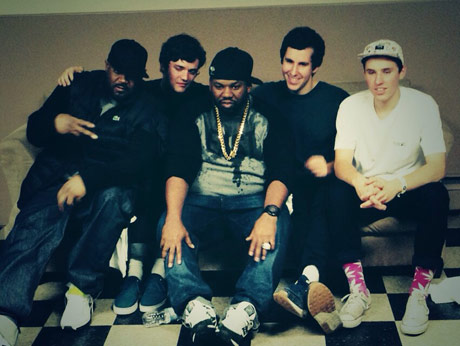It all started with a YouTube video. Three young men flipped Odd Future songs into a jazz medley in an abandoned apartment. The drummer wore a pig mask. They were christened the Odd Trio via cardboard sign.
Toronto musicians Matthew A. Tavares, Chester Hansen and Alex Sowinski first met in Humber College’s Music Performance program, bonding over a common love for Odd Future, Gucci Mane and Lil B. With Matthew on piano and synths, bassist Chester, and Alex on drums, they began jamming casually and the Odd Trio was assembled.
The first Odd Trio video became a viral sensation as they cultivated a devoted online fan base. They dropped new videos regularly and millions of hits later, newly christened Badbadnotgood released their self-titled EP in June 2011. It was a complete UFO upon arrival on the musical landscape. Tavares’ virtuosity on keys, Sowincki’s human drum machine prowess and Hansen’s in-pocket swing on bass redefined the possibilities of what a trio can do. Inspired equally by Lil B or John Coltrane, Badbadnotgood found the post-bop in Big Apple classics (“The World Is Yours”, “Mass Appeal”, “Electric Relaxation”), Zelda themes or the off-kilter electronic soundscapes of Flying Lotus.
In September 2011, BBNG sold out their debut show at Toronto’s Red Light Club. Soon after, a friendship on Twitter led to jam sessions with Tyler the Creator while he was in Toronto. The moment was captured on Youtube and spread through the web like wildfire, soon followed by an opening set for Roy Ayers and a headlining performance in London for Gilles Peterson’s Worldwide Award show in December 2011.
Nothing seems to stop these three.
BadBadNotGood released an astounding album in February of this year – Sour Soul isthe collaborative album with Staten Island rap champ and Wu-Tang Clan member Ghostface Killah. Inspired by 1960s and 70s music – taking inspiration from the recording techniques and production of that era, and eschewing sampling in favour of live instrumentation, BBNG with producer Frank Dukes have created a dramatic, cinematic musical staging for Ghostface’s vivid storytelling. Sour Soul also features guest spots from MF DOOM, Elzhi (Slum Village / J Dilla), Danny Brown and prodigal new rapper Tree (Project Mayhem).
Eric: So, despite asking the obvious, what really attracted to you to work with Ghostface?
Frank Dukes: At the time I was doing a lot of work with him, I loved him as an artist and I felt like it was just a real natural collaboration. I feel like BadBadNotGood, they really care about music and not to sound cheesy but they care about making art and not anything else, really. I feel like Ghostface has a parallel career. While he’s had a long, lucrative career these guys were just like – in their early stages and I felt like it was the perfect.
Eric: Earlier in the day when you guys were rehearsing with Ghost Face, he was actually give you some pretty solid advice, about following your own path, and don’t listen to the naysayers.
Matt Tavares: I think if you try and cater to other people then you’re not being yourself. Then you can’t really make art in that case, because you really have to express yourself for it to be a true artistic thing. It’s like, sometimes it’s depressing to read when people say negative things or when people are saying you’ve put a lot of work in, then when people say good things about it you just ignore it. You take it for granted.
Chester Stone Hansen: Hearing him saying it on a life perspective of starting in the Wu-Tang Clan, all the trials and tribulations of being a worldwide phenomenon and successful everywhere but then their dynamic as a group shifting and changing over time. So many different things he was telling us but it was crazy and so honoring to hear him say that. When someone of his stature and his experience tells you that you’re good – woah, this is meaningful stuff.
Eric: Tell me a little bit about the collaboration process.
Matt: We went to New York and Dukes basically was working at the studio with Menahan Street Band, they’re an amazing band for a 50 Cent record that didn’t get cleared, but they loved the sample so much that they met up with Dukes and hit it off instantly. Then they gave him the key to the studio and he hung out there for a while. Dukes, after we met, was like hey let’s go down to Dunhams, the studio, and record some stuff. It’s all analog and they have a very purist, it’s a very authentically very purist old school sound. That’s where we laid the bed tracks, we had about 5 days there. We spent 18 hours a day in the studio and just wrote 11 songs.
Frank: From there we just – kind of like, sent those initial 11 recordings to Ghost and built a foundation of the songs we were doing and over the course of the next couple of years hatched his way into them, changed some instrumentals and wrote a few new things and kind of massaged it into the record it is today.
Eric: What are you most excited about for people to hear on this record, showing the audience this side of the band that maybe they haven’t seen before?
Chester: Maybe a more refrained side. No solos on this record, which almost every song on all of our other records had solos on it. It sounds like a small thing, but it really changes how you scope the song. Obviously Ghostface is on top, so that creates a lot of interest. Still, it’s very easy for us because we get so used to it to write a song, solo, finish the song. It’s a completely different style of songwriting.







